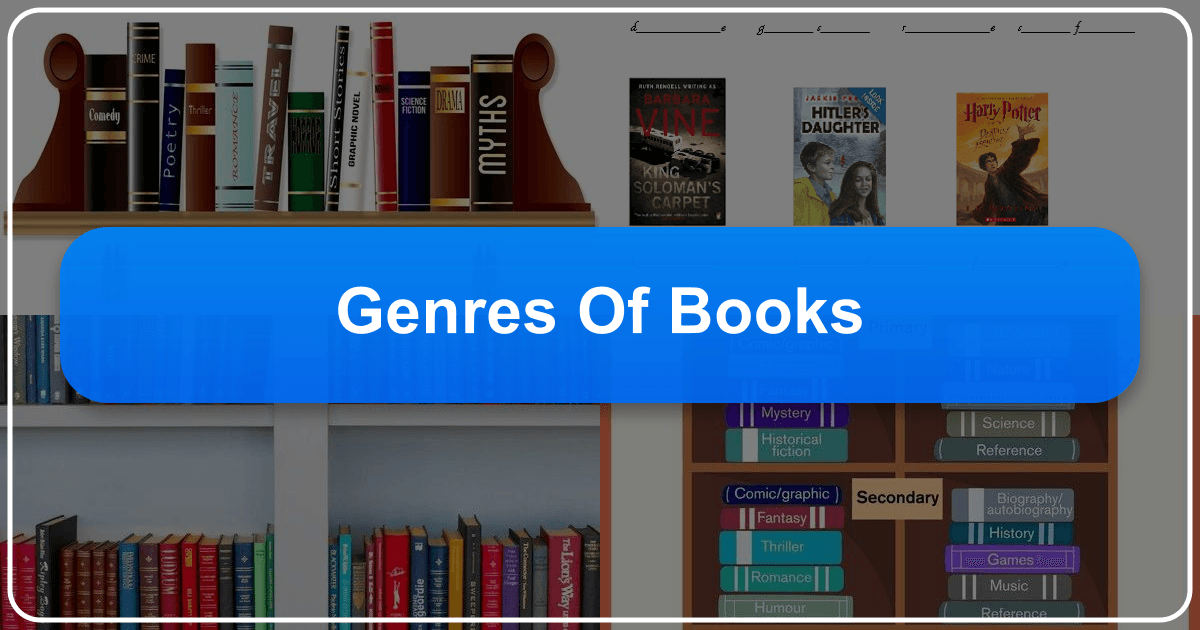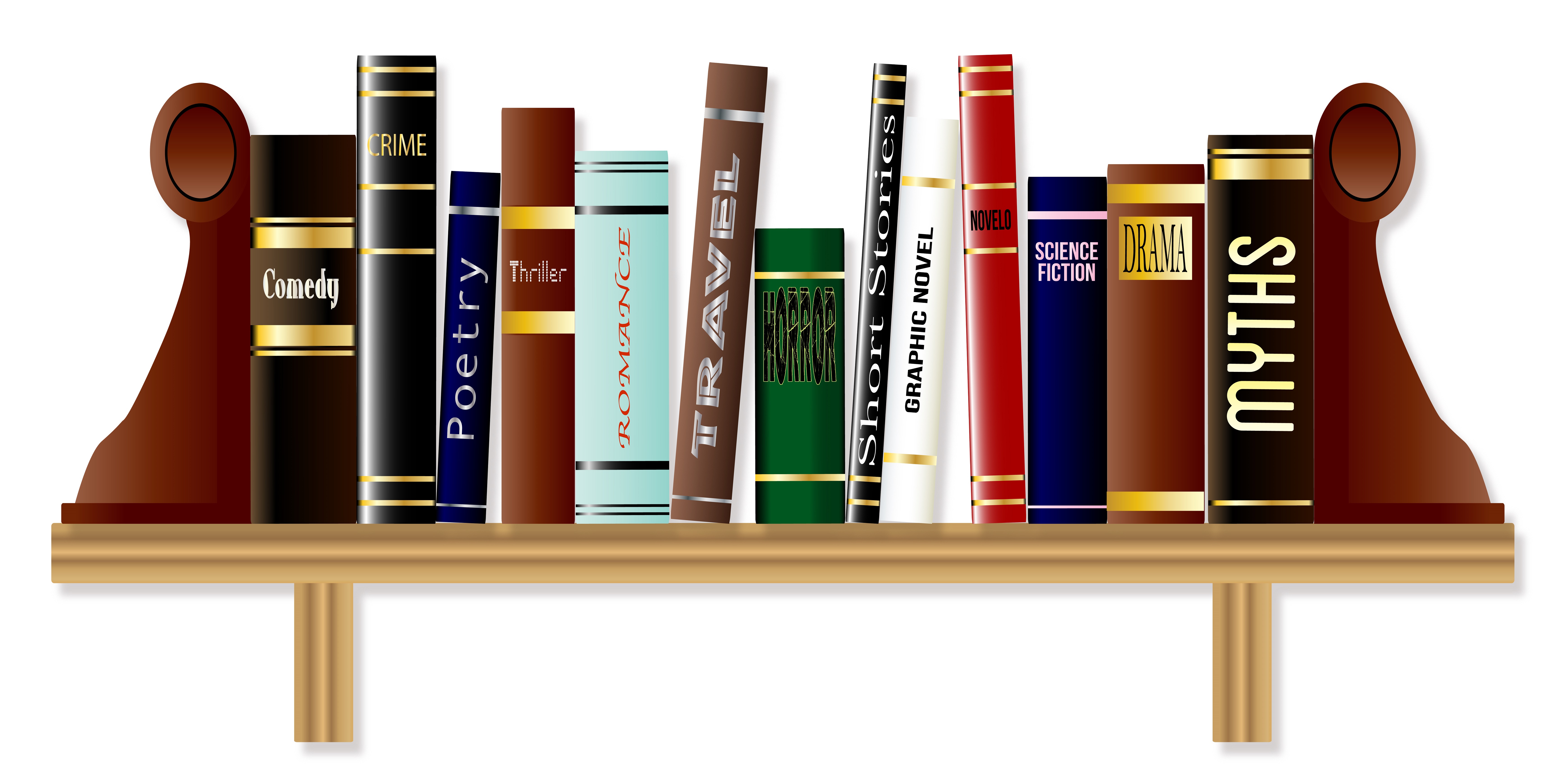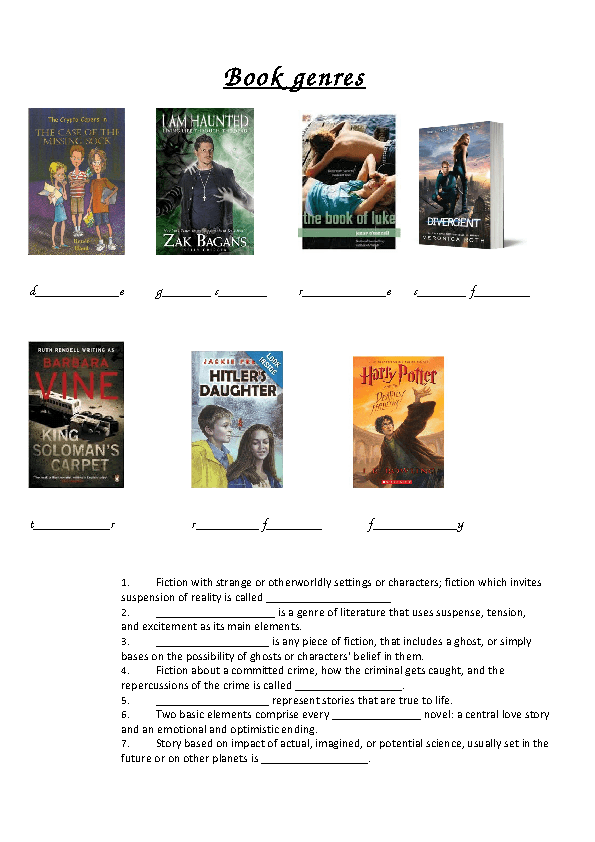Book Genres: A Comprehensive Guide

The world of literature is vast and varied, encompassing millions of titles across countless themes and styles. Navigating this literary landscape can feel overwhelming, but understanding book genres provides a valuable framework for exploration and discovery. This guide delves into the intricacies of book genres, helping you understand their significance, identify popular categories, and ultimately, find your perfect read.
What is a Book Genre?
A book genre is a category of literary composition characterized by a particular style, form, or content. Derived from the French word “genre,” meaning “kind” or “type,” genres help organize the sheer volume of published works, making it easier for readers to find books that align with their preferences. These categories are determined by the subject matter, setting, plot structure, and overall aesthetic of the story. While a single book might neatly fit into one genre, many books blend elements of multiple genres, creating hybrid forms that enrich the reading experience. The classification of books into genres is not a rigid system; it’s a dynamic, evolving process subject to ongoing discussion and re-evaluation.
Genre serves the reader first and foremost. With hundreds of thousands of books published annually, genres act as helpful signposts, guiding readers towards potentially enjoyable titles. Even if an author doesn’t precisely fit a genre label, using the closest descriptor can effectively connect their work with the intended audience. While genre categorization might seem to oversimplify complex narratives, it’s a practical tool that streamlines the book-discovery process. Crucially, genre classification frequently centers on the aesthetic qualities of the narrative world—the look and feel—rather than solely on plot, themes, or narrative structure. A genre essentially indicates the type of atmosphere and setting the reader can expect to encounter, enhancing anticipation and setting the stage for understanding the story.

How to Identify a Genre?
Genre establishes reader expectations, influencing both book selection and interpretation. It’s often the first piece of information readers seek when choosing a book. Genres range from broad classifications (like fiction and nonfiction) to highly specific subgenres (such as paranormal romance or gothic horror). Readers employ genre as a means of navigating the diverse literary landscape, selecting texts that resonate with their preferred aesthetic worlds. These expectations directly impact the reader-writer relationship, shaping how a text is perceived and appreciated. No universally accepted definition of genre exists, making the subject inherently open to continuous discussion and refinement. A deeper understanding of genre helps readers predict what to expect from a particular text.
A useful way to remember the core elements of a genre is through this simple equation: Story (Action) + Plot + Character + Setting = Genre. Analyzing these components in a book’s description, focusing on details of the main character, the book’s setting, and key plot points, offers significant insights into its genre and potential subgenres. The purpose and context of the text description further inform genre identification. Grouping together books that share similarities can also aid in identifying common genre attributes.

Popular Book Genres: A Survey
The spectrum of book genres is practically limitless. However, certain genres consistently enjoy widespread popularity. The most fundamental division lies between fiction and nonfiction. Fiction comprises narratives with invented characters and plots, although they might be set in real-world locations or historical periods. Nonfiction, on the other hand, is grounded in factual events and information. Nonfiction itself branches into numerous subgenres, ranging from biographies to technical manuals.
Popular Fiction Genres:
-
Young Adult (YA): Targeted at readers aged 13-17, YA literature explores themes relevant to adolescence, such as identity formation, relationships, and navigating the complexities of growing up.
-
Fantasy: A highly popular genre characterized by the presence of magic, mythical creatures, and often, entirely fictional worlds with unique rules and systems. Subgenres include high fantasy, urban fantasy, and dark fantasy.
-
Children’s Literature: Encompassing books written for children aged 0-8, this genre serves multiple crucial roles in a child’s development: fostering self-understanding, enhancing empathy, expanding knowledge of the world, and cultivating appreciation for the aesthetics of language.
-
Science Fiction: Exploring futuristic settings, advanced technologies, and often, extraterrestrial life, science fiction stimulates imagination and grapples with scientific possibilities and social implications. Subgenres include cyberpunk, dystopian fiction, and space opera.
-
Thrillers/Suspense: Maintaining high tension and suspense throughout, thrillers often involve perilous situations, danger, and an action-packed plot that keeps readers engaged and on the edge of their seats.
-
Paranormal: Featuring supernatural elements like ghosts, psychic phenomena, or otherworldly beings, paranormal fiction often blends elements of horror, mystery, or romance. Unlike fantasy, paranormal fiction typically incorporates real-world settings.
-
Romance: Focusing on romantic relationships as the central plot driver, romance novels explore the development of love, intimacy, and emotional connection between characters. Numerous subgenres exist, including historical romance, contemporary romance, and paranormal romance.
-
Historical Fiction: Set in the past, historical fiction weaves fictional narratives within real historical contexts and time periods. These narratives often explore significant historical events, figures, or societal issues.
Popular Nonfiction Genres:
-
Memoir: Presenting a personal account of significant life experiences, memoirs often explore a specific theme or period in the author’s life, offering insights into personal growth, relationships, and societal influences.
-
Self-Help: Aimed at personal development and improvement, self-help books provide strategies, techniques, and guidance for addressing various aspects of life, including relationships, productivity, mindset, and personal well-being.
-
Religion/Spirituality: Exploring religious beliefs, practices, and spiritual experiences, these books can encompass historical accounts, theological discussions, personal reflections, and guidance on spiritual practices.
-
Biography/Autobiography: Biographies tell the life story of a particular person, often a public figure, while autobiographies present the author’s own life narrative. These accounts offer insights into individual lives and their impact on society.
-
Business/Finance: Covering aspects of business management, finance, economics, and entrepreneurship, these books provide practical advice, theoretical frameworks, and case studies related to building and managing successful businesses.
-
History: Presenting factual accounts of past events, historical books offer insights into different periods, cultures, and societal structures. The level of detail and interpretative approach can vary greatly across different titles.
-
Health & Fitness: Encompassing a wide range of topics related to physical and mental well-being, these books offer information on nutrition, exercise, mental health practices, and specific health conditions.
The Expanding Universe of Book Genres
Beyond the popular genres listed above, numerous other well-established and niche genres exist, showcasing the continuous evolution and diversification of literature. These include:
-
Adventure: Featuring journeys, quests, or expeditions as the central plot elements, adventure narratives emphasize exploration, challenges, and personal growth.
-
Contemporary: Set in the present day, contemporary literature explores modern life, relationships, and social issues, often incorporating multiple subgenres.
-
Dystopian: Depicting societies characterized by oppressive social control and often, technological dominance, dystopian fiction critiques existing power structures and explores societal issues through cautionary tales.
-
Mystery: Centered around the solving of a crime or puzzle, mystery narratives often involve detectives, investigators, and suspenseful plot twists.
-
Cookbooks: Providing recipes, instructions, and often, culinary narratives and cultural insights, cookbooks bridge food, culture, and personal expression.
-
Art: Encompassing books on art history, artistic techniques, analyses of specific artworks, or profiles of artists, this genre celebrates the diverse world of visual arts.
-
Motivational: Offering inspiration and strategies for personal achievement and overcoming challenges, motivational books often overlap with self-help and other genres.
-
Travel: Documenting travel experiences, offering travel guides, or providing cultural insights into different destinations, this genre appeals to wanderlust and curiosity about the world.
-
Humor: Employing wit, satire, and comedic elements, humorous books aim to entertain and provoke laughter.
-
Classics: These are works that have endured through time, continuing to resonate with readers due to their enduring themes and literary merit.
-
Literary Fiction: Often characterized by complex themes, character development, and stylistic experimentation, literary fiction delves into the human condition and explores philosophical or social issues.
-
Mythology: Exploring myths and legends from various cultures, these narratives offer insights into cultural beliefs, values, and storytelling traditions.
-
Philosophy: Examining fundamental questions about existence, knowledge, values, reason, mind, and language, philosophy books delve into complex concepts and ideas.
-
Alternative Beliefs: Exploring non-mainstream belief systems such as astrology, psychic phenomena, or spiritual practices, these books offer alternative perspectives and interpretations.
-
Educational Texts: Providing instruction and information within the educational framework, educational texts include textbooks, lesson plans, and other learning materials.
-
Reference: Offering factual information and structured data, these works include dictionaries, encyclopedias, and other reference materials.
Choosing Your Genre: A Personal Journey
The act of choosing a book genre is deeply personal, reflecting both the writer’s and reader’s unique preferences and experiences. Understanding your own preferences allows you to enhance your reading experience. Identifying genres that align with your preferred themes, styles, and emotions is a crucial step in finding books that resonate with you. Most people intuitively grasp the characteristics of well-known genres, enabling them to effectively navigate the literary landscape. However, keep in mind that many subgenres blur the lines between established categories.
By considering the following factors, you can narrow your selection process and optimize your reading choices:
-
Preferred appeals: Identify the elements that most draw you to certain books—is it the plot, characters, setting, or writing style? These preferences help point you toward genres that frequently incorporate these elements.
-
Genre expectations: Understand the general conventions of each genre, allowing you to align your expectations with the type of reading experience you seek.
-
Narrowing options: Once you identify preferred genres, explore the vast array of books within those categories.
-
Seeking recommendations: Utilize online resources, reviews, library recommendations, or discussions with fellow readers to discover hidden gems.
Reading is a powerful tool, offering entertainment, learning, and inspiration. The vast selection of available books can be daunting, but leveraging the power of genre classifications helps readers find titles that captivate and enrich their literary journeys. This guide, hopefully, provides a stepping stone to navigate the world of book genres, fostering a more fulfilling and rewarding reading experience.